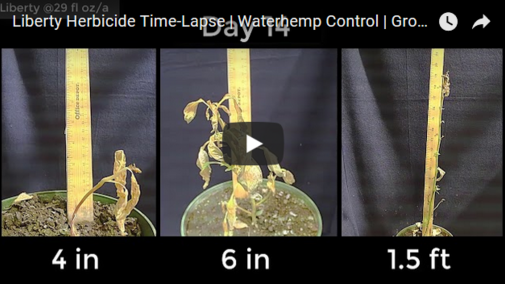Six weeds have been confirmed resistant to glyphosate in Nebraska due to repeated application of glyphosate in Roundup Ready® corn-soybean production systems. The increasing prevalence of herbicide-resistant weeds is compelling growers to diversify weed management practices. LibertyLink® technology in corn and soybean provides an opportunity to apply Liberty (active ingredient: glufosinate; site-of-action group 10) as a postemergence on top of the crop canopy.
Liberty is a water-soluble non-selective herbicide that can control a broad spectrum of emerged broadleaf and grass weeds. It is a contact herbicide, which means it only kills the plant parts contacted by the herbicide. Small weed size and uniform spray coverage are necessary for optimum control of emerged weeds.
Following are spraying guidelines to be considered to ensure maximum weed control with Liberty:
This time lapse video compares the effects of Liberty applied to waterhemp that was 4, 6 and 18 inches tall. (Video by Debalin Sarangi)1. Target the weeds at their early growth stage. Liberty should be applied when weeds are less than 4 inches tall. The bigger the weeds at the time of control, the smaller the chances for effective weed control. Moreover, shoot-regrowth can be seen when Liberty is sprayed on a weed more than 4 inches tall. The time-lapse video shows why weed height is important for Liberty application. It captures a UNL study on control of glyphosate-resistant common waterhemp using Liberty at 29 fluid ounces per acre applied when plants are 4, 6 and 18 inches tall. Shoot regrowth is visible on treated plants more than 4 inches tall.
2. Follow the instructions listed on herbicide label. The Liberty label notes that the herbicide can be applied at 32 to 43 fluid ounces per acre as a burndown (before planting), and at 29 to 43 fluid ounces per acre in LibertyLink corn and soybeans as a postemergence (with a cumulative maximum of 87 fluid ounces per acre per year). Liberty should be applied at a full rate to avoid the selection pressure on weeds. All Liberty applications must be made more than 60 days before harvesting corn forage and 70 days before harvesting corn grain and soybean.
It's recommended that ammonium sulfate (AMS) be mixed with Liberty at 1.5 to 3 pounds per acre, depending on the tank-mix partners, to improve weed control efficacy, especially for difficult-to-control weeds, such as velvetleaf, common lambsquarters, giant ragweed, and pigweed. A minimum of 15 gallons of carrier volume per acre is needed to ensure good spray coverage. The volume can be increased up to 20 gallons per acre in a dense weed canopy. Medium to coarse spray droplets are necessary to reduce the spray drift to sensitive crops; however, flood jet nozzles should not be used for Liberty application. Examples of recommended nozzles are TeeJet VisiFlo Flat, XR TeeJet Extended Range Flat, Turbo TwinJet Flat, or TurboDrop XL. Liberty should be applied when wind speed is less than 10 miles per hour to reduce spray drift.
3. Spray on a warm and sunny day. The efficacy of Liberty is maximized by warm temperatures, high humidity, and bright sunlight. Liberty should be applied from two hours after sunrise to two hours before sunset. Avoid spraying when a heavy dew or fog is present and weeds are under stress due to drought, cold, or extended cloudiness. Rainfall within four hours of Liberty application may wash out the herbicide and reduce its efficacy.
Glufosinate-Resistant Weeds in the US
Italian ryegrass has been confirmed resistant to Liberty in California and Oregon. It’s important to diversify weed management practices to delay the evolution of resistance to Liberty. Rotating crops, selecting for herbicide-resistant traits, and using herbicides with multiple “effective” sites-of-action is recommended to reduce selection pressure.

